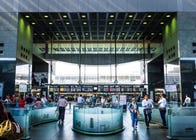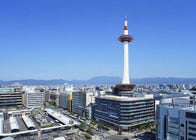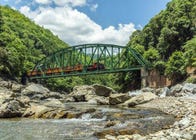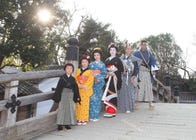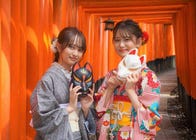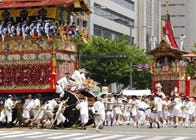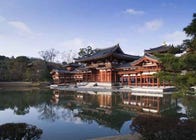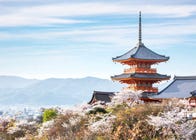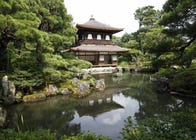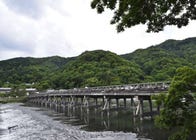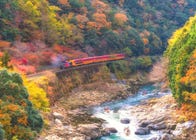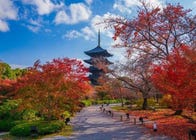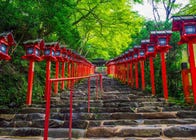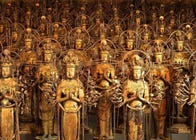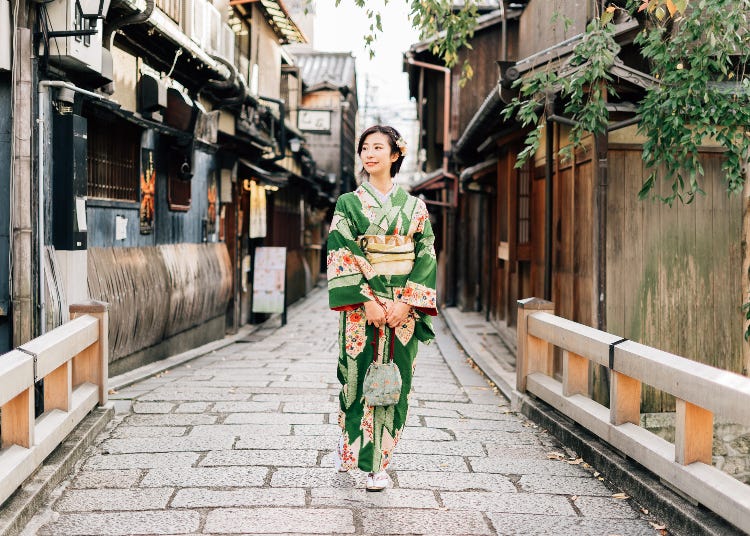
Kyoto is a must-visit destination when heading to the Kansai region in Japan. There are so many iconic sightseeing spots, including the Kiyomizu Temple and Arashiyama (the bamboo forest), and unique cultural experiences you can only enjoy in Kyoto!
Here are 38 things you can do in Kyoto, so take a good look at this list and pick out the ones you want to do!
Main image: PIXTA
Getting to Kyoto and Public Transportation in Kyoto
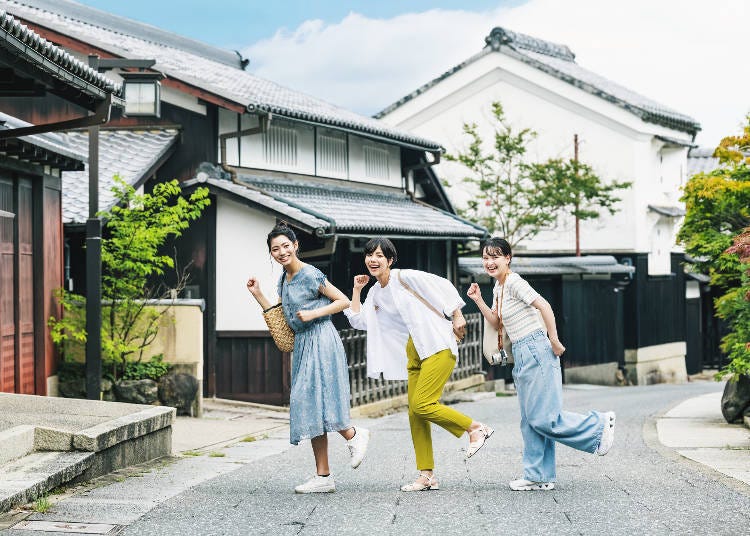
Firstly, here’s also a quick rundown on how to access Kyoto.
Access from Kansai International Airport (KIX)
Unfortunately, there are no airports in Kyoto, the closest airports are Kansai International Airport (KIX) and Itami Airport (Osaka International Airport). As well as having flights from overseas, KIX can also be easily accessed via Narita Airport or Haneda Airport in Tokyo in around one hour, with some cheap flights starting at around 5,000 yen. From KIX, you can take the local trains or a bus which will directly take you to Kyoto in around 80 minutes.
Traveling from Osaka to Kyoto
The most convenient method of transport from Osaka to Kyoto is to take the train. You can take the special rapid train on the JR Kyoto Line which takes 29 minutes from JR Osaka Station to Kyoto Station for 570 yen. You could also take the shinkansen (bullet train) to Kyoto, which takes only 15 minutes but will set you back 1,420 yen. Both are covered by the Japan Rail Pass.
Other options include taking the Hankyu Kyoto Main Line from Hankyu Osaka-Umeda Station, which will get you to Kyoto-Kawaramachi Station (central Kyoto) in 44 minutes for 400 yen. Another option is the Keihan Main Line, leaving Yodoyabashi Station and arriving at Sanjo Station.
Traveling from Tokyo to Kyoto
There are multiple ways, ranging from buses, shinkansen, and by air to get to Kyoto from Tokyo.
One of the most popular options is the shinkansen. Tokyo and Kyoto are connected via the JR Tokaido Shinkansen. A regular one-way fare starts at around 13,320 yen. If you are able to get a Japan Rail Pass, this shinkansen ride can also be covered by it. Beware, the Japan Rail Pass only covers the Hikari and Kodama trains.
If you are looking to budget and want a more affordable way to travel, or not planning to get a Japan Rail Pass, using the highway bus is a great option. Prices will vary heavily depending on the season and days you decide to go, but some cheap tickets can start at around 3,000 yen! The trip takes around 7 – 8 hours and there is an option of taking the day bus or the night bus, so when you wake up you will have arrived at your destination.
Getting Around Kyoto
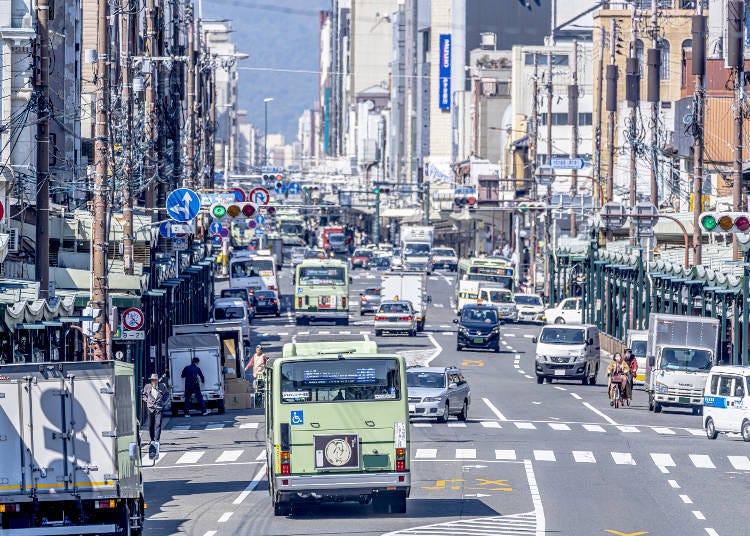
Kyoto has an abundance of public transport which are easy to use and many will conveniently stop by popular tourist destinations. Buses, subways, and trains are most commonly used by both tourists and locals. Some tourist spots, such as Kinkaku-ji and Ginkakuji, are not located near train stations and hence it is easier to use a bus. Buses in Kyoto have a flat fare of 230 yen (within the city center.) There are also unlimited day passes available, with some passes giving you discounts at various tourist spots when presented.
Recommended All Year-Round Attractions in Kyoto
1.Kyoto Station: The gateway to Kyoto and a hot spot filled with different restaurants and shops
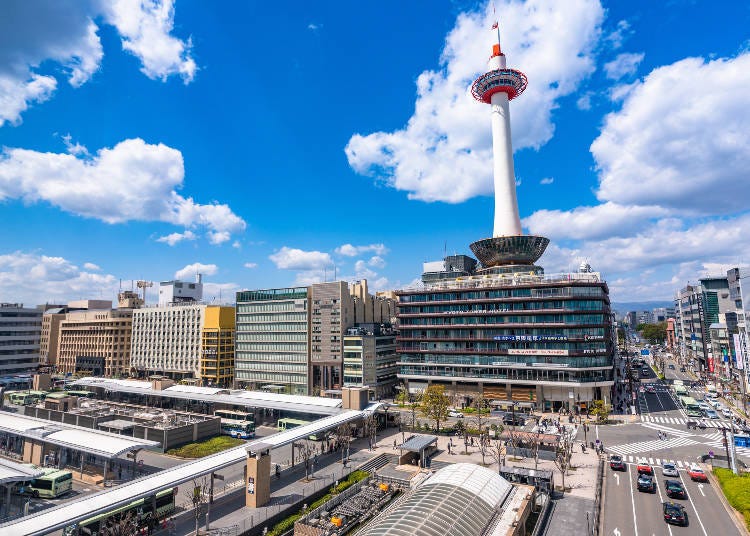
The first Kyoto Station was built in 1877 just a little north of the current structure, using red brick - the most modern material available at the time. The present Kyoto Station was completed in 1997. Made of glass and steel, it is visually striking and very different from the traditional structures Kyoto is most known for.
As Japan’s second-largest train station, Kyoto Station was constructed to accommodate the millions of visitors the city sees each year. Inside the station complex is a department store, hotel, theater, and numerous restaurants and shops. It is also a nice rest place to take a break from all of the sightseeing you will be doing.
-

-
Address
Kyoto Station Building, 901 Higashishiokoji-cho, Shiokoji-dori, Karasuma-dori, Shimogyo-ku, Kyoto-shi, Kyoto, 600-8216
View Map -
Nearest Station
Kyoto Station (JR Tokaido Line / JR Biwako Line / JR Tokaido Shinkansen / JR Kyoto Line / JR Sagano Line / JR San-in Line / JR Nara Line / Karasuma Line / Kintetsu-kyoto Line)
- Phone Number 075-361-4401
-
Address
Kyoto Station Building, 901 Higashishiokoji-cho, Shiokoji-dori, Karasuma-dori, Shimogyo-ku, Kyoto-shi, Kyoto, 600-8216
2. Kyoto Tower: Climb the tallest building in Kyoto to take in the beautiful ancient city
Kyoto Tower stands at 131m tall, and amongst the ancient temples and shrines, this modern landmark is a beauty to see. Climb to the viewing platform and take in a 360 view of the beautiful ancient history!
-
Kyoto Tower京都タワー
- Address 721-1 Higashishiokojicho, Shimogyo Ward, Kyoto, 600-8216
3. Nishiki Market: Visit “Kyoto’s Kitchen” filled with all things food related, from fresh produce to cookware
Nishiki Market is a fantastic place to find the best seasonal foods and delicious Kyoto specialties such as Japanese sweets, pickles, seafood, and sushi! Over 130 stores line the market today. The market also attracts visitors from across Japan and the world who are looking to buy Kyoto specialties, making it a bustling destination all day long. A great way to experience the local Kyoto cuisine! (Many shops offer free samples too!)
-

-
Address
609, Nishidaimonjicho, Tominokoji-dori Shijo-sagaru, Nakagyo-ku, Kyoto-shi, Kyoto, 604-8054
View Map -
Nearest Station
Shijo Station (Karasuma Line)
3 minutes on foot
- Phone Number 075-211-3882
-
Address
609, Nishidaimonjicho, Tominokoji-dori Shijo-sagaru, Nakagyo-ku, Kyoto-shi, Kyoto, 604-8054
4. Fushimi Inari Taisha Shrine: Relish in the stunning sight of the beautiful red torii gates
The Fushimi Inari Taisha Shrine is one of the most famous tourist spots and is known for the rows and rows of red torii gates. Constructed over 1,300 years ago, Fushimi Inari Taisha has more than 30,000 sub-shrines all over Japan, conferring blessings of a bountiful harvest, business success, familial stability, and the granting of wishes.
The most striking place is the “Thousand Shrine Gates”, which, as the name suggests, is a continuous line of the red gates. This was gifted by those who had their prayers and wishes granted, and the gates have been there since the Edo period. If you don’t have any time, make sure to at least see this path of gates, and if you have a few hours to spend, try walking through the gates around the mountain.
-

-
Address
68, Fukakusayabunouchicho, Fushimi-ku, Kyoto-shi, Kyoto, 612-0882
View Map -
Nearest Station
Inari Station (JR Nara Line)
- Phone Number 075-641-7331
-
Address
68, Fukakusayabunouchicho, Fushimi-ku, Kyoto-shi, Kyoto, 612-0882
5. Arashiyama Bamboo Forest: Travel through the beautiful bamboo forest and enjoy the beauty of the city
You can walk to the Arashiyama Bamboo Forest from Saga-Arashiyama Station, about 15 minutes by train from JR Kyoto Station. Beloved as prime villa grounds by nobles for over a thousand years, it’s a very popular area for its beautiful nature and wealth of temples. The Arashiyama Bamboo Forest is a spot loved by both locals and tourists for good reason. The surreal experience of being surrounded by the never-ending rows of bamboo trees is one you must enjoy yourself. No photo will be able to capture this unique experience.
-

-
Address
Saga Ogurayama Tabuchiyama Town, Ukyo Ward, Kyoto City, Kyoto Prefecture, 616-8394
View Map -
Nearest Station
Torokko Arashiyama Station (Sagano Scenic Railway)
1 minute on foot
- Phone Number 075-213-1717
-
Address
Saga Ogurayama Tabuchiyama Town, Ukyo Ward, Kyoto City, Kyoto Prefecture, 616-8394
6. Kyoto Railway Museum: Take your family to learn all about the history of Japanese railway systems
This museum showcases over 50 retired trains and shows from steam trains to recent electric trains. It can be a great place to take children to or to head to when the weather is not looking good.
-

-
Address
Kankijicho, Shimogyo-ku, Kyoto-shi, Kyoto, 600-8835
View Map -
Nearest Station
Umekojikyotonishi Station (JR Sagano Line)
3 minutes on foot
- Phone Number 0570-080-462
-
Address
Kankijicho, Shimogyo-ku, Kyoto-shi, Kyoto, 600-8835
7. Toei Kyoto Studio Park: Become a samurai or ninja from the Edo period for a day
Toei Kyoto Studio Park was born in 1975 as Japan’s first theme park where visitors can enjoy historical Edo period drama sets and experience the world as it was during that time. Dress up as a samurai or geisha and enjoy stepping back in time.
-

-
Address
Kyoto Prefecture, Kyoto City, Ukyo Ward, Uzumasa Higashihachiokacho 10, 616-8162
View Map -
Nearest Station
Uzumasa Station (JR Sagano Line / JR San-in Line)
5 minutes on foot
- Phone Number 0570-06-4349
-
Address
Kyoto Prefecture, Kyoto City, Ukyo Ward, Uzumasa Higashihachiokacho 10, 616-8162
8. GEAR Theatre: Enjoy the only non-verbal stage play in Japan
This is a one-of-a-kind theater, where you can enjoy a non-verbal performance, which will stimulate your five senses as you see the story unfold before your eyes. Be prepared to be amazed by the endless amount of tricks and amazing performances!
-
GEAR /Non-Verbal theatreギア専用劇場
- Address 1928 Building 3F, Benkeiishicho 56, Nakagyo Ward, Kyoto 604-8082
9. Kimono: Explore the streets of Kyoto while dressed up in a beautiful kimono
Experience Kyoto while wearing a beautiful kimono! There are kimono rental stores in Kyoto Station, around Kiyomizu-dera Temple, Arashiyama, and Higashiyama, etc., where you can experience everything from dressing, makeup, hair style, clogs, and accessories. Many stores have foreign language staff on hand, so foreign visitors can feel at ease. In addition to traditional kimonos, cooler yukata are also available in the summer, and some stores even have romantic Taisho-style hakama to wear. Rent a kimono and take Instagram-worthy photos and fully immerse yourself in the history-filled streets of Kyoto!
10. Hanami-koji: Take a stroll along Hanami-koji to unveil the mystery of the geisha and maiko
Gion is known as the entertainment district of Kyoto, and within it is Hanami-koji, where beautiful traditional buildings stand. While taking a stroll through Hanami-koji you may be lucky enough to see some maikos and geishas.
-

-
Address
Gionmachiminamigawa, Higashiyama-ku, Kyoto-shi, Kyoto, 605-0074
View Map -
Nearest Station
Gionshijo Station (Keihan Line)
5 minutes on foot
-
Address
Gionmachiminamigawa, Higashiyama-ku, Kyoto-shi, Kyoto, 605-0074
Recommended Spring Attractions in Kyoto: Don’t Miss Out on the Pink Cherry Blossoms!
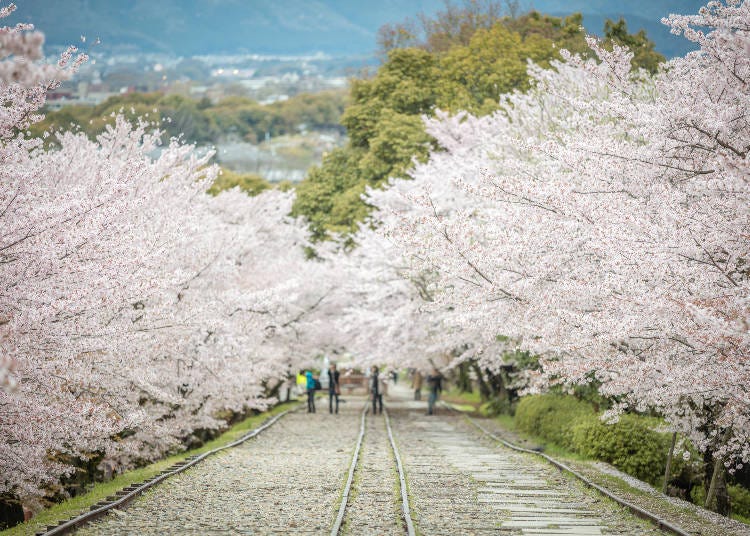
11. Keage Incline: An Instagram worthy beautiful location
Keage Incline is a disused railway that is open to the public. Take a walk, and enjoy the beautiful views of the cherry blossoms. It’s a beautiful place to snap a photo for your Instagram as well!
-

-
Address
Nanzenjifukuchicho, Sakyo-ku, Kyoto-shi, Kyoto, 606-8435
View Map -
Nearest Station
Keage Station (Tozai Line)
9 minutes on foot
-
Address
Nanzenjifukuchicho, Sakyo-ku, Kyoto-shi, Kyoto, 606-8435
12. Ninnaji Temple – Enjoy the sea of cherry blossoms
Ninna-ji Temple is an impressive temple complex in northern Kyoto, created as a summer retreat for the Imperial Family and founded in 886. It was tradition for a member of the Imperial Family to act as head priest, and this custom lasted until 1867, when the Imperial household moved to Tokyo. The temple grounds are extensive and contain an elegant five-story pagoda, a huge main gate, beautifully landscaped gardens, teahouses, prayer halls, and living quarters. It is also famous for its locally cultivated late-blooming cherry blossom trees, named Omuro Cherries. These flowers are late blooming hence usually bloom around the middle of April.
-

-
Address
33, Omuroouchi, Ukyo-ku, Kyoto-shi, Kyoto, 616-8092
View Map -
Nearest Station
Omuroninnaji Station (Keifuku Dentetsu-kitano Line)
3 minutes on foot
- Phone Number 075-461-1155
-
Address
33, Omuroouchi, Ukyo-ku, Kyoto-shi, Kyoto, 616-8092
13. Daigoji Temple: Also known as the legendary “Temple of Flowers”
Daigoji Temple has been well-known for its extravagant cherry blossoms ever since the Heian period, with both tourists and locals flocking to view this magnificent sight.
-

-
Address
22, Daigohigashiojicho, Fushimi-ku, Kyoto-shi, Kyoto, 601-1325
View Map -
Nearest Station
Daigo Station (Tozai Line)
10 minutes on foot
- Phone Number 075-571-0002
-
Address
22, Daigohigashiojicho, Fushimi-ku, Kyoto-shi, Kyoto, 601-1325
14. Nijo Castle: The perfect place to enjoy cherry blossoms at night
Nijo Castle is a World Heritage Site consisting of a moat, two concentric walls, gardens and the remains of a tenshu tower. It was built in 1603 by Ieyasu Tokugawa, first shogun of the Edo era, with the purpose of housing the Military Commissioner of Kyoto and the shogun when he visited Kyoto. During the cherry blossom season, the history-filled Nijo Castle has a sakura illumination festival. With over 300 sakura trees, all are illuminated at night so visitors can enjoy the cherry blossoms at night as well.
-

-
Address
541 Nijojocho, Horikawa Nishiiri, Nijo-dori, Nakagyo-ku, Kyoto-shi, Kyoto, 604-8301
View Map -
Nearest Station
Nijojomae Station (Tozai Line)
- Phone Number 075-841-0096
-
Address
541 Nijojocho, Horikawa Nishiiri, Nijo-dori, Nakagyo-ku, Kyoto-shi, Kyoto, 604-8301
15. Heian Jingu Temple: A century-old temple decorated by beautiful cherry blossoms
The Heian Jingu Temple is known for its stunning display of weeping cherry blossoms. It is one of the best locations to view the weeping cherry blossoms in Kyoto.
-

-
Address
97, Okazakinishitennoucho, Sakyo-ku, Kyoto-shi, Kyoto, 606-8341
View Map -
Nearest Station
Higashiyama Station (Tozai Line)
10 minutes on foot
- Phone Number 075-761-0221
-
Address
97, Okazakinishitennoucho, Sakyo-ku, Kyoto-shi, Kyoto, 606-8341
16. Maruyama Park: Explore the beauty of the century-old cherry blossoms
Kyoto’s oldest park, Maruyama Park is located near Yasaka Shrine and has become one of the most popular and crowded spots for cherry blossom viewing parties in Kyoto, during the spring season! They have an iconic weeping cherry blossom tree as a centerpiece which is also lit up at night.
-

-
Address
473, Maruyamacho, Higashiyama-ku, Kyoto-shi, Kyoto others, 605-0071
View Map -
Nearest Station
Gionshijo Station (Keihan Line)
13 minutes on foot
- Phone Number 075-561-1350
-
Address
473, Maruyamacho, Higashiyama-ku, Kyoto-shi, Kyoto others, 605-0071
17. Kyoto Prefectural Botanical Garden: Take a walk to find your favorite cherry blossoms
A relaxing garden, perfect to take a walk and enjoy the variety of cherry blossoms they have on display. This is especially a great option if you want to avoid crowding!
-

-
Address
Shimogamo Hangi Town, Sakyo Ward, Kyoto City, Kyoto Prefecture, 606-0823
View Map -
Nearest Station
Kitayama Station (Karasuma Line)
- Phone Number 075-701-0141
-
Address
Shimogamo Hangi Town, Sakyo Ward, Kyoto City, Kyoto Prefecture, 606-0823
Recommended Summer Attractions in Kyoto: Cool Off in the Lush Greenery!
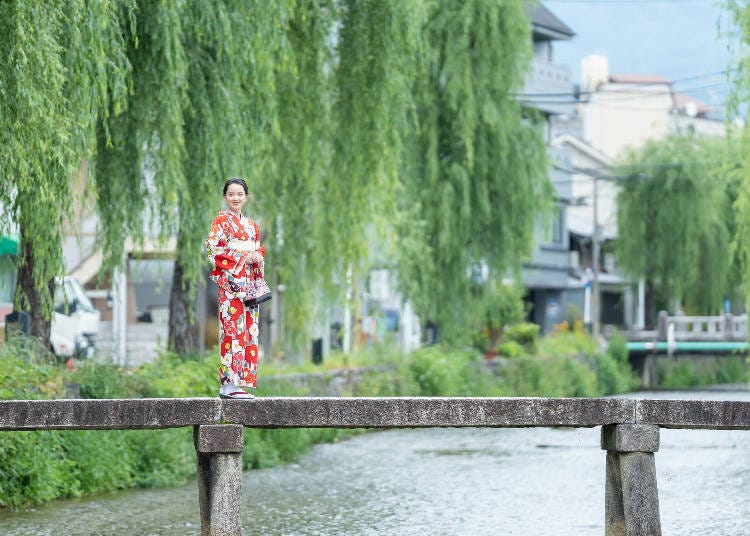
18. Kamogawa Nouryo-Yuka: Enjoy the summer breeze with the locals
The Kamogawa Nouryu-Yuka is a part of the summer tradition in Kyoto and has been passed down since the Edo period. It is where open-air seating is created by the Kamo River by various restaurants and tea shops so people can enjoy the summer breeze along with traditional Japanese cuisine.
19. Nanzen-ji Temple: A photogenic location with a magnificent aqueduct and dry landscape gardens
One of the most photogenic temples in Kyoto, with an extravagant brick aqueduct standing in front of the temple and a beautiful garden that will set your heart at peace.
-

-
Address
Nanzenjifukuchicho, Sakyo-ku, Kyoto-shi, Kyoto, 606-8435
View Map -
Nearest Station
Keage Station (Tozai Line)
10 minutes on foot
- Phone Number 075-771-0365
-
Address
Nanzenjifukuchicho, Sakyo-ku, Kyoto-shi, Kyoto, 606-8435
20. Nanzenji Junsei: Get a taste of authentic Kyoto tofu in soup
Kyoto’s Nanzenji Temple is gorgeous in every season, and it seems a postcard-perfect photo awaits at every turn. There are many beautiful spots in Nanzenji Temple for snapping photos, such the brick aqueduct and the garden representing a Zen interpretation of the world. Here you can also enjoy one of Kyoto’s famous foods, yudofu, alongside a beautiful view of the gardens of Nanzen-ji Temple and at the location where it originated from
-
Nanzenji Junsei南禅寺 順正
- Address 60 Nanzenji Kusakawacho, Sakyo Ward, Kyoto 606-8437
21. Kyo no Tanabata Festival: Head to Nijo Castle to enjoy a classic Kyoto summer festival
Enjoy the various nighttime events celebrating “Tanabata,” the Star Festival. Tanabata began around the year 700 and has origins in a Chinese legend of two stars and lovers, Hikoboshi and Orihime, who were separated by the Milky Way and only able to meet once a year on July 7. During the event, people write their wishes on paper and hang them on bamboo branches, in the hope that the stars will make them come true. You can enjoy this stunning display of illuminated strips of paper with bamboo leaves around the Kamo River and Nijo Castle areas.
-

-
Address
541 Nijojocho, Horikawa Nishiiri, Nijo-dori, Nakagyo-ku, Kyoto-shi, Kyoto, 604-8301
View Map -
Nearest Station
Nijojomae Station (Tozai Line)
- Phone Number 075-841-0096
-
Address
541 Nijojocho, Horikawa Nishiiri, Nijo-dori, Nakagyo-ku, Kyoto-shi, Kyoto, 604-8301
22. Gion Festival: Experience a classic Japanese summer festival
This is one of Japan’s three most famous festivals, held in the Gion district during the whole of July. The festival started as a religious ritual to appease the gods following a deadly plague in 869. The festival’s highlight is the ‘Yamahoko Junko,’ a parade held on the 17th and 24th of July, where decorated wagons are pulled through the streets. In the days before the parade, the streets are lined with night stalls selling snacks and sweets. Enjoy the bustling crowds of people as they gather to eat, drink, and have fun watching the procession!
-

-
Address
Yasaka Shrine and others, Kyoto Prefecture Higashiyama Ward, Kyoto City, 605-0000
View Map -
Nearest Station
Kyoto Station (JR Tokaido Line / JR Biwako Line / JR Tokaido Shinkansen / JR Kyoto Line / JR Sagano Line / JR San-in Line / JR Nara Line / Karasuma Line / Kintetsu-kyoto Line)
20 minutes by bus
- Phone Number 075-561-6155
-
Address
Yasaka Shrine and others, Kyoto Prefecture Higashiyama Ward, Kyoto City, 605-0000
23. Byodoin Temple: A World Heritage Site that you might have seen on the back of the 10 yen coin
This famous temple in Uji is known to feature on the Japanese 10 yen coin, making this remarkable temple a must-visit. During the summer season, you will find the ponds blooming with pink lotus flowers.
-

-
Address
116,Ujirenge, Uji-shi, Kyoto, 611-0021
View Map -
Nearest Station
Uji Station (JR Nara Line)
10 minutes on foot
- Phone Number 0774-21-2861
-
Address
116,Ujirenge, Uji-shi, Kyoto, 611-0021
Recommended Autumn Attractions in Kyoto: Some of the Most Popular Maple Viewing Spots
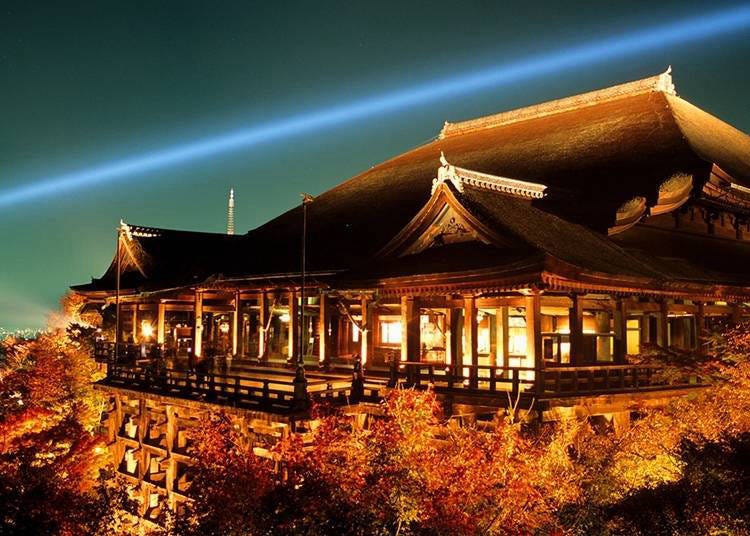
24. Kiyomizu-dera Temple: Head over to take pictures of the gorgeous maple trees with the beautiful temple
Kiyomizudera Temple is one of the can’t-miss points of interest in Kyoto. The old historic temple, reportedly opened in the year 778, is a designated world heritage site. Its 130,000 square meter premises are situated halfway up the side of Mt. Otowayama and include over 30 buildings and monuments. One of the most well-known tourist spots in Kyoto, while it may be crowded with many tourists, it is well worth the visit. The stunning autumn foliage is unique to the season and the light-ups are a must-visit!
-

-
Address
1-294 Kiyomizu, Higashiyama-ku, Kyoto City, Kyoto Prefecture, 605-0862
View Map -
Nearest Station
Gionshijo Station (Keihan Line)
25 minutes on foot
- Phone Number 075-551-1234
-
Address
1-294 Kiyomizu, Higashiyama-ku, Kyoto City, Kyoto Prefecture, 605-0862
25. Ginkaku-ji Temple: Enjoy the stunning different shades of red leaves surrounding the temple
Not to be confused with Kinkaku-ji Temple, this temple is known for the harmony of the white sand and lushly growing moss in its neatly manicured garden and the beauty created by the Zen temple’s quiet and peaceful atmosphere. During winter, the beautiful gardens of the temple are filled with various shades of autumn colors and it is a great way to enjoy the unique autumn view with the stunning history-filled temple.
-

-
Address
2, Ginkakujicho, Sakyo-ku, Kyoto-shi, Kyoto, 606-8402
View Map -
Nearest Station
Mototanaka Station (Eizan Dentetsu Eizan Line)
28 minutes on foot
- Phone Number 075-771-5725
-
Address
2, Ginkakujicho, Sakyo-ku, Kyoto-shi, Kyoto, 606-8402
26. Togetsu-kyo Bridge: An iconic spot of Arashiyama and a beautiful view of the maple trees
A landmark in western Kyoto for over 400 years, this wooden bridge spans the Katsura River in the historic Arashiyama district. The Togetsu-kyo Bridge alone is a must-visit, but in autumn, you get both the stunning view of the iconic bridge and the mountains, which have turned into warm autumn colors!
-

-
Address
Sagatenryuji Suenobaba Town, Ukyo Ward, Kyoto City, Kyoto Prefecture, 616-8385
View Map -
Nearest Station
Arashiyama Station (Keifuku Dentetsu-arashiyama Line)
3 minutes on foot
- Phone Number 075-411-9990
-
Address
Sagatenryuji Suenobaba Town, Ukyo Ward, Kyoto City, Kyoto Prefecture, 616-8385
27. Sagano Scenic Railway: Journey through the stunning foliage
This sightseeing train in Arashiyama runs along the Hozugawa River and gives you a stunning look at the nature of the area. It is also perfect during autumn to ride directly through the stunning autumn scenery.
-

-
Address
Kurumamichicho, Saga Tenryu-ji, Ukyo-ku, Kyoto-shi, Kyoto, 616-0000
View Map -
Nearest Station
Torokko Saga Station (Sagano Scenic Railway)
2 minutes on foot
- Phone Number 075-861-7444
-
Address
Kurumamichicho, Saga Tenryu-ji, Ukyo-ku, Kyoto-shi, Kyoto, 616-0000
28. The Philosopher’s Walk: Escape from the city and take a slow walk
The Philosopher’s Walk (Tetsugaku-no-michi) is a stone path that follows the small canal between Ginkaku-ji Temple and Nanzen-ji Temple in eastern Kyoto. It is a wonderful place to take a stroll and to retreat from the city and maybe enjoy some local foods. It passes by a number of quiet and picturesque temples, and is renowned as one of the best places to enjoy the cherry blossoms in the spring, when beautiful pink blossoms overhang the path like a canopy. In autumn, portions of the trail are transformed into gorgeous, fiery scenery.
-

-
Address
Kyoto Prefecture Kyoto City Sakyo Ward Jodo Temple Ishibashi Town-Wakaoji Town, 606-8406
View Map -
Nearest Station
Kyoto Station (JR Tokaido Line / JR Biwako Line / JR Tokaido Shinkansen / JR Kyoto Line / JR Sagano Line / JR San-in Line / JR Nara Line / Karasuma Line / Kintetsu-kyoto Line)
40 minutes by bus
- Phone Number 075-761-3863
-
Address
Kyoto Prefecture Kyoto City Sakyo Ward Jodo Temple Ishibashi Town-Wakaoji Town, 606-8406
29. Ryoanji Temple: Experience the Zen aesthetics and autumnal scenery
Ryoanji Temple is well-known for its rock garden, with fifteen stones carefully placed on a bed of raked white gravel. A viewing platform allows visitors to take in the scene, although from whatever angle you view the garden, you can never see all fifteen stones at once. No one knows when or who designed the garden or what it signifies, and this mystery just adds to the garden’s allure. The grounds of the temple become especially striking during the autumn season.
-

-
Address
13, Ryoan-ji Goryounoshitacho, Ukyo-ku, Kyoto-shi, Kyoto, 616-8001
View Map -
Nearest Station
Ryoanji Station (Keifuku Dentetsu-kitano Line)
7 minutes on foot
- Phone Number 075-463-2216
-
Address
13, Ryoan-ji Goryounoshitacho, Ukyo-ku, Kyoto-shi, Kyoto, 616-8001
30. Toji Temple: Home to the iconic five-story pagoda
Toji Temple’s five-story, 55m high pagoda has long been a Kyoto landmark and pillar of spiritual and community life. When heading to Toji Temple, remember to take a picture of the five-story pagoda. See for yourself the outstanding pagoda which was built to help protect from negative spiritual energies.
-

-
Address
1, Kujocho, Minami-ku, Kyoto-shi, Kyoto, 601-8473
View Map -
Nearest Station
Toji Station (Kintetsu-kyoto Line)
10 minutes on foot
- Phone Number 075-691-3325
-
Address
1, Kujocho, Minami-ku, Kyoto-shi, Kyoto, 601-8473
Recommended Winter Attractions in Kyoto: Enjoy the Snow-Covered Winter Wonderland
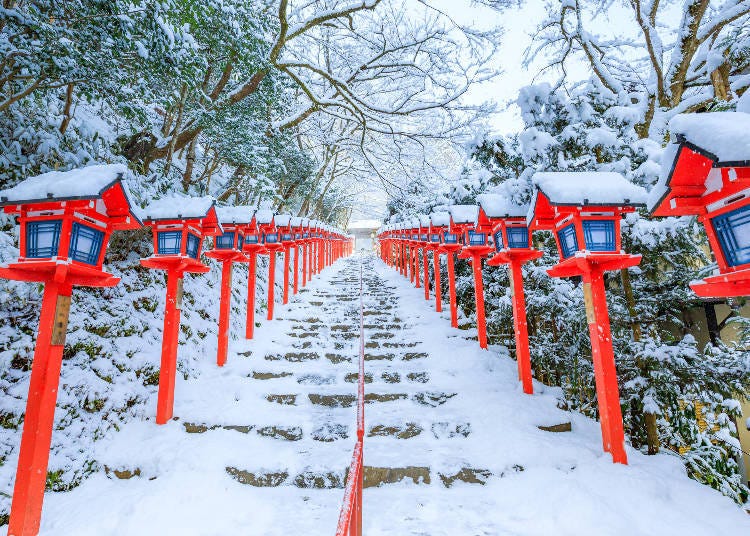
31. Kifune Shrine: Enjoy the romantic view of the snow with the red lanterns
Kifune Shrine sits at the foot of Mount Kurama in Sakyo Ward, about a 40-minute drive from Kyoto’s center. Kasuga lanterns line the stone stairway leading up to the shrine. This otherworldly view representative of the shrine is often shown on TV and in magazines. In winter, with the snow settling onto the grounds, the stark contrast between the white snow and red lanterns turns the landscape into a magical winter wonderland.
-

-
Address
180, Kuramakibunecho, Sakyo-ku, Kyoto-shi, Kyoto, 601-1112
View Map -
Nearest Station
Kibuneguchi Station (Eizan Dentetsu-kurama Line)
30 minutes on foot
- Phone Number 075-741-2016
-
Address
180, Kuramakibunecho, Sakyo-ku, Kyoto-shi, Kyoto, 601-1112
32. Sanjusangendo: Home to 1001 Statues of Kannon
A must-visit temple, home to 1001 statues of Kannon. No photo can do it justice, and when you see the rows of statues, it is sure to leave you stunned.
-

-
Address
657, Sanjusangendomawaricho, Higashiyama-ku, Kyoto-shi, Kyoto, 605-0941
View Map -
Nearest Station
Shichijo Station (Keihan Line)
7 minutes on foot
- Phone Number 075-561-0467
-
Address
657, Sanjusangendomawaricho, Higashiyama-ku, Kyoto-shi, Kyoto, 605-0941
33. Higashi Honganji Temple: Don’t miss out on the stunning winter landscape
Higashi Honganji Temple is one of the two large temples in the center of Kyoto. Its stunning garden and ponds are open to the public and become a surreal romantic view during winter.
-

-
Address
Higashitamamizucho, Shimojuzuyamachi-dori Ainomachi Higashi-iru, Shimogyo-ku, Kyoto-shi, Kyoto, 600-8190
View Map -
Nearest Station
Kyoto Station (JR Tokaido Line / JR Biwako Line / JR Tokaido Shinkansen / JR Kyoto Line / JR Sagano Line / JR San-in Line / JR Nara Line / Karasuma Line / Kintetsu-kyoto Line)
6 minutes on foot
- Phone Number 075-371-9210
-
Address
Higashitamamizucho, Shimojuzuyamachi-dori Ainomachi Higashi-iru, Shimogyo-ku, Kyoto-shi, Kyoto, 600-8190
34. Kinkaku-ji Temple: Enjoy as the temple shines brightly amongst the white snow
While Kinkakuji Temple is stunning no matter the season, during winter and when the snow has set, the temple becomes one of the most spectacular views one must see. The stark contrast between gold and white will leave you breathless.
-

-
Address
1, Kinkakujicho, Kita-ku, Kyoto-shi, Kyoto, 603-8361
View Map -
Nearest Station
Kitanohakubaicho Station (Keifuku Dentetsu-kitano Line)
20 minutes on foot
- Phone Number 075-461-0013
-
Address
1, Kinkakujicho, Kita-ku, Kyoto-shi, Kyoto, 603-8361
35. Amanohashidate
Amanohashidate is known as one of the ‘Three Most Famous Views in Japan’. According to legend, it was created as a path to the heavens by the deity Izanagi-no-Mikoto. The sandbar stretches for 3.6 kilometers, and visitors can enjoy walking or cycling from one end to the other. And while stunning throughout the year, during winter the view becomes one of a kind. As the snow slowly covers all of the greenery, this is a view you must see for yourself.
-

-
Address
Monju, Miyazu-shi, Kyoto, 626-0001
View Map -
Nearest Station
Amanohashidate Station (Tantetsu Miyatoyo Line)
7 minutes on foot
- Phone Number 0772-22-8030
-
Address
Monju, Miyazu-shi, Kyoto, 626-0001
36. Ine Town: Also known as the “Venice of Japan”
Ine Town is in the northern part of Kyoto Prefecture, on the coast of the Sea of Japan. It is about a 20-minute drive from the scenic Amanohashidate. Ine’s unique houses are directly in front of the sea, and the first floor is used as a storage place for boats, while living quarters are on the second floor. The houses lining the seafront in the town are of construction unique to this area. It is beautiful during the summer, and in winter, it is transformed into a beautiful snow globe when the flurries settle. It is also a great place to enjoy winter seafood delicacies.
37. Miyama Thatched-Roof Village: A cute small village in Kyoto
A small traditional Japanese village north of Kyoto which will make you feel like you went back in time. Miyama Kayabuki no Sato has thatched-roof houses built from 220 (Edo period) to 150 years ago (Meiji period), with 39 of the 50 houses still inhabited. In winter, it is a great way to see what Japan was like back in the day.
-

-
Address
Miyamachokita, Nantan-shi, Kyoto, 601-0712
View Map -
Nearest Station
Wachi Station (JR San-in Line)
33 minutes by bus
- Phone Number 0771-77-0660
-
Address
Miyamachokita, Nantan-shi, Kyoto, 601-0712
38. Hozu River Cruise: Experience a tour of Arashiyama’s winter landscape
The Hozugawa River Cruise (Hozugawa Kudari) is a popular 2-hour, 16km cruise past cherry blossoms in spring and stunning autumn foliage in fall. Don’t worry, the boats are heated so you can enjoy the views without freezing!
-

-
Address
2, Shimonakajima, Hozucho, Kameoka-shi, Kyoto, 621-0005
View Map -
Nearest Station
Kameoka Station (JR Sagano Line / JR San-in Line)
9 minutes on foot
- Phone Number 0771-22-5846
-
Address
2, Shimonakajima, Hozucho, Kameoka-shi, Kyoto, 621-0005
▼Related links
- Area
- Category
*Prices and options mentioned are subject to change.
*Unless stated otherwise, all prices include tax.
Recommended places for you
-

Osaka JOINER
Other Sightseeing
Namba, Dotonbori, Shinsaibashi
-
Goods

Yoshida Gennojo-Roho Kyoto Buddhist Altars
Gift Shops
Nijo Castle, Kyoto Imperial Palace
-

Jukuseiniku-to Namamottsuarera Nikubaru Italian Nikutaria Sannomiya
Izakaya
Kobe, Sannomiya, Kitano
-

Kambei Sannomiyahonten
Yakiniku
Kobe, Sannomiya, Kitano
-
Events

Sunflower terminal (Osaka) Terminal 1
Other Sightseeing
USJ, Nanko Port
-

Kanzenkoshitsuyakinikutabehodai Gyugyu Paradise Sannomiya
Yakiniku
Kobe, Sannomiya, Kitano
-
Ad

Visiting the Osaka–Kansai Expo? Enjoy These 5 Great Itineraries from Osaka-umeda for Nature and City Lovers
-

Dorsett by Agora Osaka Sakai: Stay in a World Heritage Port Town Surrounded by History and the Sea (Newly Opened in 2025)
by: Yotsuka Hizuki
-

Experience Hotel New Otani Osaka: Overnight Journey of Japanese Culture and Fine Dining (2-Day Itinerary)
by: Yotsuka Hizuki
-

Foreign tourists outnumber Japanese ones at Kyoto hotels for first time ever
-

Hyogo Prefecture Guide: Destinations, Activities, Travel Advice, Shopping & More
by: Kaori Kimura
-

Hotel Universal Port: A Fun-Filled Stay Where You Can Meet the Minions (In-Depth Review)
by: Tabiningen
Inspiration for Accommodations
-

Spacious Family Hotel in Namba: 20 Comfortable Stays for Family Fun
-

Charming Hotels to Enjoy the Spectacular Views of Arashiyama's Autumn Leaves from Your Room
-

Experience Stunning Views of Osaka Castle from Private Spaces: Top Hotels Near Osaka Castle
-

Recommended by Visitors! Arashiyama's Best-Rated Hotels
-

Family-Friendly Universal Studios Japan Hotel with Excellent Access
-

Enjoy a Comfortable Stay in Osaka! 10 Hotels with Convenient Airport Shuttle Services
-

Top 10 Recommended Hotels Near Namba Station with Great Access
-

Enjoy Night Views from Your Room! Recommended Hotels in Namba Area
-

Osaka Namba Station Guide: Navigate Osaka's Massive Station Area Like a Pro
by: WESTPLAN
-

5 Popular Things to do in Umeda - Osaka's Central Area!
by: WESTPLAN
-

Healthcare in Japan for Tourists: What to Do When You Get Sick or Injured in Japan
-

32 Epic Things to Do in Osaka: From Historic Tours to Go-Karting, Traditional Performances, and Festival Extravaganzas
-

Autumn in Japan 2025: Fall Foliage Forecast & Where to Enjoy the Colorful Leaves (+Tour Info)
-

Everything You Need to Know About the JR Kansai WIDE Area Pass
by: James Davies
- #best gourmet Osaka
- #things to do Osaka
- #what to do in kyoto
- #what to bring to japan
- #best gourmet Kyoto
- #new years in Osaka
- #what to buy in nanba
- #Visiting Osaka
- #onsen tattoo friendly arima
- #daiso
- #Visiting Kyoto
- #best japanese soft drinks
- #japanese fashion culture
- #japanese convenience store snacks
- #japanese nail trends















